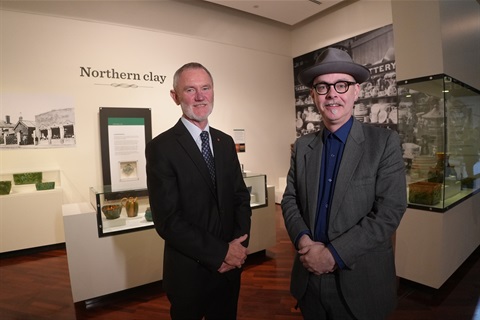QVMAG delves into Launceston's proud pottery past

Image: City of Launceston Mayor Albert van Zetten and Senior Curator of Art and Design Ashley Bird, standing in the new Northern Clay exhibition space at the Museum at Inveresk.
Launceston residents familiar with places like Brickfields Reserve and Pipeworks Road may not often consider where these names originated.
But these names bear witness to Launceston's past as a major pottery and ceramics hub; a legacy which is being celebrated in a new exhibition at the Queen Victoria Museum at Inveresk.
The new exhibition, Northern Clay, officially opens to the public at the Museum at Inveresk this weekend and explores the story of the rise of ceramics in Northern Tasmania beginning with two former Launceston pottery companies — John Campbell Pottery and McHugh Brothers.
Launceston Mayor Albert van Zetten said he hoped the exhibition would shine new light on an often forgotten aspect of Launceston's past.
'The stories represented in Northern Clay are absolutely fascinating, especially as they relate to some of Launceston's most well-known early infrastructure projects,' Mayor van Zetten said.
'However, a takeaway for me is that even today Launceston is still home to a vibrant community of potters who are continuing a tradition established by John Campbell Pottery and McHugh Brothers, and ensuring it remains alive and well in Northern Tasmania.'
Exhibition co-curator Ashley Bird said it was likely that many Launceston families had decorative ornaments produced by Campbell's or McHugh's in their homes.
'Both McHugh's and Campbell's were big industrial manufacturers in their time, producing pipes and bricks for major infrastructure projects like the Albert Hall, the Cameron street post office and Launceston's sewerage system,' Mr Bird said.
'However, they also produced many small-scale decorative ceramics — items like character jugs, Launceston souvenirs, vases, decorative ornaments as well as garden fountains and water filters.
'One of the things Campbell and McHugh were famous for was the production of ornamental frogs — the type of thing you might stick in your garden — but also these wonderful dog doorstops which were made in kelpie, golden retriever and Great Dane designs.
'These days those smaller decorative ceramics are highly prized by collectors, and there will be many Launceston families out there who might unknowingly have one of these pieces sitting on a mantelpiece or on a bookshelf.'
Image: Campbell's Tasmanian Pottery display, in the Tasmanian International Exhibition, Albert Hall, Launceston, Tasmania, 1891. John Campbell is visible on the right.QVMAG Collection QVM:1991:P:0896
McHugh Brothers was established in 1873 while John Campbell Pottery was established in 1880.
Both factories were situated on Wellington Street, South Launceston, and enjoyed a friendly rivalry.
'McHugh and Campbell were located only a short distance apart and of course they had a rivalry — but they also shared moulds, they shared employees, and they cooperated with each other on government and council contracts,' Mr Bird said.
'At the heart of both businesses were two men who had a fundamental love of pottery, who supported independent studio potters, and who have left us this amazing legacy we're celebrating in Northern Clay.'
Northern Clay is the latest exhibition module within the Tasmanian Connections gallery at the Museum at Inveresk and will open to the public from Saturday 9 April 2022.